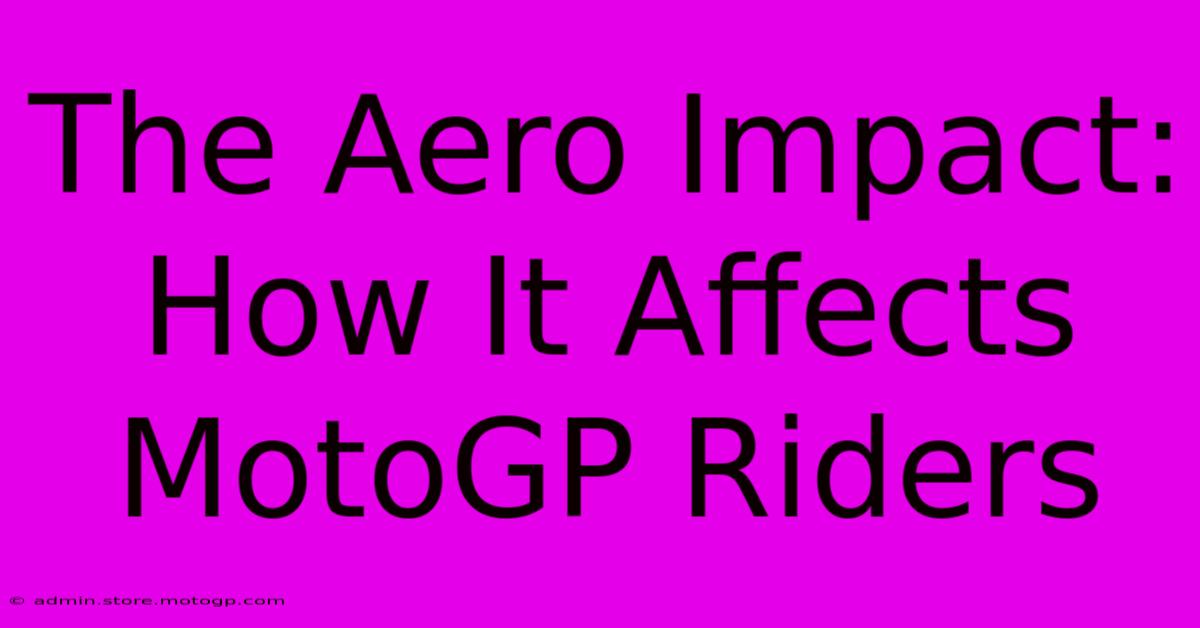The Aero Impact: How It Affects MotoGP Riders

Table of Contents
The Aero Impact: How It Affects MotoGP Riders
The roar of the engines, the blur of speed, the breathtaking maneuvers – MotoGP is a spectacle of skill and technology. But beyond the rider's talent lies a crucial element often overlooked by casual viewers: aerodynamics. The aero impact on MotoGP riders is immense, shaping racing strategies, influencing rider performance, and ultimately determining race outcomes. This article delves into the complex relationship between aerodynamics and MotoGP riders, exploring its effects on both their physical and strategic approaches to the sport.
The Physics of Speed: Understanding Aerodynamic Forces
At MotoGP speeds, aerodynamic forces are significant. Downforce, generated by aerodynamic devices like wings and winglets, pushes the bike towards the track. This improves stability at high speeds, allowing riders to lean into corners more aggressively and maintain higher speeds through turns. Conversely, drag resists the bike's forward motion, slowing it down. The constant battle between maximizing downforce and minimizing drag is a key challenge for engineers and riders alike.
The Role of Aerodynamic Devices
Modern MotoGP bikes are heavily sculpted, incorporating various aerodynamic devices designed to optimize performance. These include:
- Wings and Winglets: These generate downforce, enhancing stability and cornering speeds. Their design is crucial, balancing downforce gains with the increase in drag.
- Fairings: The entire bodywork of the bike is designed to minimize drag and channel airflow efficiently. Even small changes to the fairing's shape can have a noticeable impact on performance.
- Underbody Aerodynamics: The area beneath the bike also plays a significant role. Careful shaping here can generate additional downforce, further enhancing stability.
The Rider's Experience: Physical and Strategic Implications
The aero impact isn't simply about the bike's speed; it directly influences the rider's experience in several crucial ways:
Physical Strain
The increased downforce, while beneficial for stability, also means the rider has to fight against significantly stronger forces. This leads to increased physical strain, particularly on the neck and arms, requiring exceptional strength and endurance. Riders regularly train intensely to withstand these forces.
Strategic Advantages and Disadvantages
Aerodynamics significantly impact racing strategy. A bike with superior aerodynamic performance can maintain higher speeds through corners, gaining valuable time over competitors. However, this advantage can be negated by adverse weather conditions, where excess downforce might become detrimental in wet or windy races.
Adaptability and Setup
Different tracks require different aerodynamic setups. A circuit with many fast corners might demand a setup prioritizing downforce, whereas a track with tight, slow corners might benefit from a setup focused on minimizing drag. Riders and their teams must constantly adapt their setup to optimize performance for each individual race.
The Future of Aero in MotoGP
Aerodynamic development in MotoGP is ongoing, with teams continuously striving for marginal gains. The search for the perfect balance between downforce and drag is an ever-evolving process, fueled by technological advancements in computational fluid dynamics (CFD) and wind tunnel testing. Future innovations might include even more sophisticated aerodynamic devices and possibly even active aerodynamic systems that adjust in real time based on track conditions and rider input.
Conclusion: More Than Just Speed
The aero impact in MotoGP is far-reaching, affecting everything from rider physique to race strategy. It's not merely about raw speed; it's about the delicate balance of forces, the constant adaptation, and the ongoing technological arms race that makes this sport so compelling. As technology continues to evolve, the influence of aerodynamics on MotoGP will only grow, shaping the future of this exhilarating motorsport.

Thank you for visiting our website wich cover about The Aero Impact: How It Affects MotoGP Riders. We hope the information provided has been useful to you. Feel free to contact us if you have any questions or need further assistance. See you next time and dont miss to bookmark.
Featured Posts
-
Moto Gp Austin 2025 Get Your Tickets Before They Re Gone
Feb 18, 2025
-
Witness Speed Austin F1 Qualifying
Feb 18, 2025
-
The Power Of American Moto Gp
Feb 18, 2025
-
Motorcycle Helmet Safety Beware Of Counterfeits
Feb 18, 2025
-
Malaysia Moto Gp Experience The Thrill Of Victory
Feb 18, 2025
